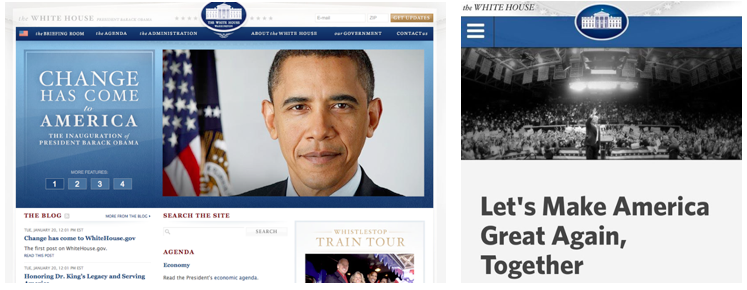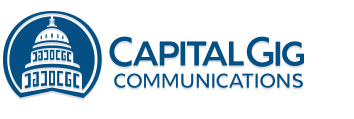Any time the White House changes hands, especially between two different political parties, there are going to be some hurdles during transition. However, it appears that current federal digital properties are presenting some additional challenges that are more difficult for some to overcome.
First, the White House website comes to mind. When President George W. Bush arrived in office in January 2001, there was a basic blue-framed temporary website with a handful of pages that was developed while the ultimate website was being built. Eventually, a more advanced site was launched complete with an unique content management system and several new features which served the administration well for over six years until a final WH.gov re-design was launched in March 2007.
Several months before January 2009, to avoid similar delays for the incoming president, the Bush 43 team embarked upon a comprehensive project to ensure that whoever won the presidency (Sen. Obama or Sen. John McCain), there would be a new, capable website ready and waiting for them on Day One. At 12 PM ET on 1/20/2009, President Obama’s inauguration day, the Bush site was archived and the new site for President Obama was launched.
As a side, when the Obama site debuted, the title of one of the first posts on the newly minted White House blog was “Change comes to WhiteHouse.gov” which, of course, was borrowed from Obama’s “Hope and Change” 2008 campaign theme. Similarly, when the Trump site was launched on 1/20/17, the front page also featured a familiar “Make America Great Again” campaign message from 2016.

Almost a year later in October 2009, the Obama digital team eventually replaced the original site with a new one powered by Drupal. Despite Slate’s attempt to frame this move as a partisan “repudiation of its predecessor,” I looked at it more as an evolution in the adoption of new technology and the hope that the Drupal community would be able to better collaborate and crowdsource new innovations. Plus, it was rumored at the time that the U.S. House and U.S. Senate were also considering Drupal, thus increasing the ability for government to better connect online behind the scenes through a compatible CMS structure and uniquely designed plugins.
So, fast forward to January 2017. This piece, Trump needs time to make whitehouse.gov great again by Darren Samuelsohn, Politico, was published on 1/19/17 just before inauguration. It is unclear as to whether the Obama team prepared a new website for the incoming Trump administration but I highly doubt it. The template looks almost identical and the article points out that a new site will be months in the making. We will have to wait to hear from Trump’s new Chief Digital Officer Gerrit Lansing to learn more about what’s in store.
There has been some chatter about the “scrubbing” of content from WhiteHouse.gov which I personally believe is unfair. In my opinion, the website belongs to the sitting president for as long as that president is in office. The content should reflect the current president, especially when it comes to policy. I don’t recall anyone complaining that the Obama administration was “scrubbing” content or themes from the Bush White House website such as No Child Left Behind, The Freedom Agenda, Global War on Terror, Strengthening Social Security for Future Generations, Renewal in Iraq, etc.
All of the Bush content is archived — and now, so is the Obama White House website. Someone recently told me that they heard that 400 programmers were scouring the Trump site for comparisons with Obama’s to see what was removed or replaced. Here’s the link: https://obamawhitehouse.archives.gov/ Have fun with that!
The next issue is social media. Nancy Scola, also with Politico, published a balanced article on 1/25/17 about the struggle that some federal social media account owners are experiencing as the Obama team moves out and the Trump Administration transitions in. Similar to the website, some are having problems accepting new policy differences on issues such as climate change, immigration, health care, etc.
Again, the policies of each administration are unique and like it or not, the channels should reflect the views of the current officeholder. Elections matter and they have consequences. I’m sure that many Republicans weren’t huge fans of Obama policies or some of the content posted on official accounts, but all that changes now.
For the first time ever, social media accounts also have to transition. It wasn’t much of an issue in 2009. The Bush White House General Counsel established that Facebook, Twitter, YouTube and the like were not approved for usage among federal employees at the EOP. Only a few accounts were beginning to pop up in the administration at cabinet-level agencies and on Capitol Hill during the 2008 campaign cycle.
Now, it’s a completely different story. According to CRS’s “Social Media in Congress” study in May 2016, all 100 U.S. Senators had Twitter accounts by 2013 and just about every Member of Congress had at least one social media profile. Trump inherits a digitally engaged government built by Obama staffers over the past eight years and there’s no doubt that he plans to exploit it — especially since he is such an obsessive and prolific Twitter user himself.
However, these official accounts are not for personal opinions. They are for government communications. As harsh as it sounds, federal employees have a choice. Either they abstain from posting personal comments or they should relinquish control of the accounts. If they are further conflicted, they always have the option of resigning. In the meantime, while communications posts are still being filled, there was a request to halt the use of some social media accounts which is a good strategy regardless of politics. If a House seat is lost, should the incoming Member still retain all the staff from the previous officeholder, especially if from different political parties? Shouldn’t there be a slight pause until a new team is in place and an approval process is established? Glad to see that the idea seems to have some bipartisan support.
Some defenders of the social media hiatuses noted that federal Twitter accounts are supposed to speak for the agencies, not serve as individual employees’ political platforms. And even some Obama-era digital experts say it’s somewhat reasonable for the new administration to hit pause. — Source: Federal workers’ Twitter brushfire burns Trump by Nancy Scola, Politico, 1/25/17
Certainly, there have been several bumps already and it is going to be at least a few months before the digital operations across the federal government starts to hit its stride. That, coupled with constantly evolving technology will make it increasingly more difficult to stay ahead of the curve.
In any case, the Trump team has indicated that digital will play an integral role in their communications strategy so it will be interesting to see what innovative changes they make and — more importantly, how effective they are in positively influencing policy and improving public opinion with a hostile media in a divided political environment.
Pretty sure there isn’t an app for that.

Leave a Reply